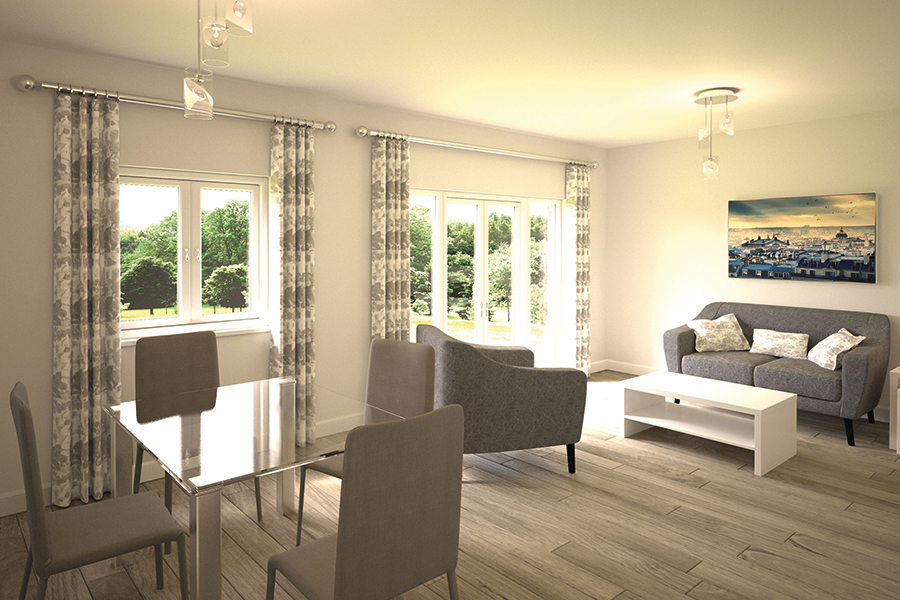PROVIDING a comfortable and safe foundation in homes where more vulnerable people may live, begins with the floor.
As a joint report – ‘FLOORED’* – from TPAS Cymru and Tai Pawb in Wales into the provision of flooring in newly-let social homes found, flooring is not just a nicety: for the majority of tenants who took part in the survey and did not have carpets or suitable flooring in their home, the lack of it actually impacted on their health and wellbeing.
They listed issues such as a lack of warmth, safety and sound in their homes; health issues, including breathing difficulties; and depression. Responses from tenants with children highlighted safety issues and an increase in isolation and loneliness in not being able to invite friends to visit.
Consider also the number of people living with dementia in the UK is forecast to cross the one million mark by 2025 (Alzheimer’s Society) and its clear specialist flooring has a growing role to play in providing a safe, reassuring and comfortable environment.
So taking the end-user of the product into serious consideration is therefore essential when it comes to specifying the technically correct type of flooring. And for those responsible for providing floorcoverings to these sectors, it means there are three key considerations – safety, practicality and durability.
High traffic areas require a more hardwearing, durable flooring than anywhere else in a property. Over time, excessive use can mean the floorcovering can lose its appeal. Hard flooring such as vinyl or safety flooring provides robust options that’ll help with appearance, retention and durability.
Underlay plays an important role too – with a good quality option highly recommended to help prolong the life of flooring. It can also reduce noise on harder surfaces and provide added warmth and insulation.
The simple addition of an entrance mat will also help protect the flooring inside a domestic property or communal space. It keeps the dirt and moisture out and stops it from being tracked inside, helping prolong the life of flooring and keeping it looking good for longer.
The use of a slip-resistant, water-resistant flooring in areas such as the kitchen and bathroom is a must. Owing to the increased potential risk of slip hazards in these areas it’s essential to select a floor that offers excellent slip-resistance and meets any necessary health and safety guidelines required for the type of property or area.
There’s a further risk of slips in specially adapted wet rooms or bathrooms which will require an enhanced slip-resistant vinyl safety floor with a raised emboss that is designed for continuous wet areas.
Softer options like carpet will always be a popular choice for bedrooms and living areas, particularly something durable and easy to maintain, such as polypropylene which is naturally stain resistant. This makes it suitable for homes where spills and accidents easily happen.
Communal areas such as corridors, stairs and lounges in shared living space are busy and noisy and demand a safe, durable and potentially sound reducing flooring solution. We work with multiple manufacturers who produce excellent safety flooring solutions for all types of applications.
While the tendency is to think of this kind of flooring as quite clinical in appearance, there are many ranges available with a choice of patterns, designs and colours to complement both modern and more traditional interiors.
Being able to provide a stylish option is important, whether it’s for the social or private sector. People have an expectation that floorcoverings are not only safe and practical, but modern and aesthetically pleasing too.
This is just as true for the 70% plus of residents in care homes suffering from dementia where floorcovering choices for living, communal or social areas need to be carefully considered. Appropriate flooring should be selected to ensure the highest in safety standards, as well as a reassuring and comfortable environment.
There are several important characteristics of dementia-friendly flooring. A matt finish with reduced sparkle is just one of them, along with a surface that reduces impact sound and one that provides a smooth transition between rooms.
Designer Contracts supplies several dementia-friendly options, that offer practicality throughout a building, while in keeping with an interior décor. One example of our work in this sector was a project we undertook in the last couple of years at the Dorothy Terry House at Redditch in Worcestershire. It’s a 42-bedroom retirement complex specialising in dementia care living.
More than 1,000sq m of communal corridors, stairs, landings and lounge areas, spread over five floors, were identified as areas in need of replacement.
Designer Contracts was asked to uplift the existing flooring which we replaced with PolySafe Wood FX safety vinyl, a high specification safety floor, combining decorative designs with sustainable slip resistance and high durability.
Featuring authentic reproductions of popular and high clarity wood designs, the range incorporates a light to dark colour spectrum with non-intrusive safety aggregates in the vinyl to create a safe yet attractive interior.
Whether in social housing, care settings or retirement homes, safety is incredibly important with a number of statutory requirements that need to be met. These include the addition of stair nosings to communal staircases, which can help reduce accidents by defining the edge of a step. Transition strips between rooms and differing flooring types are another essential accessory that help provide a safe passage between rooms.
Whatever the special requirements or location, the aim should always be to deliver a safe and durable solution, while creating a space that feels like home.
- Floored: Provision of appropriate flooring in social housing. Executive Summary published October 2020.
www.designercontracts.com
Louise Walters is commercial director for Designer Contracts


